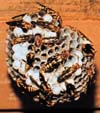
Have you ever looked at a wasp nest?

The paper wasps build their nests under the eaves of structures. Their nests are generally visible, shaped like an umbrella with a handle coming off the top and attaching to the eaves or the structure. The bottom of the nest has circular, cup-shaped holes in it. The holes of the nest that are filled with white are eggs. Wasps like to build their nests on the south or southeast side of a structure.
The mud dauber has much the same behavior as all wasps; however, its nest is like a clump of mud on the side of your building or structure. The black wasps are generally found along rooflines. They lay their eggs in or along the tiles or shingles of roofs.
Social wasps use paper (wood pulp) to construct their nests. A wasp collects wood fiber by using its mandibles (mouth parts) to scrape it from worn and weathered wooden fences, buildings, telephone poles, and other sources. Sometimes it collects fiber from man-made paper products such as paper bags or cardboard boxes. The insect then chews the wood and mixes it with saliva. This makes the wood fiber extremely soft and moist. After a period of chewing, the wasp adds the paste to the nest structure and spreads it out with her mandibles and legs.
After it thoroughly dries; a type of tough, durable paper is formed.
Have you ever closely examined or thought about the symmetrical architecture and geometrical construction of a wasp nest? How does the wasp know what materials to gather to build the nest? Who taught that wasp how to build? Did it spend time as an apprentice under a master builder wasp? Obviously a silly question, but then, where did the wasp learn how to build such a structure?
Remember: Nests are built from wood fiber collected from posts and occasionally from live
plant stems, causing some plant damage. Nests are oriented downward and are suspended by a
single filament.

Again, where did the wasp learn to construct such geometrical shapes? Where did the wasp learn the technique or the knowledge or the skill that's required? Did that wasp go to college and get a degree in Engineering? Obviously a ridiculous question. Since it would be a difficult task for a lot of average people to duplicate such a construction, is that wasp more intelligent or more skilled than people are? Of course not.
Now, evolution might say that over a long, long period of time, wasps built different structures, using different techniques and materials, until more and more wasps began to build the same type of construction, and eventually, all wasps of the same species were building the same structure, using the same formation and building materials.
Now I ask: was this possible because some mysterious construction-building gene was passed down from one wasp to another? If that's the case, scientists should research this gene, so that we can use it to pass down the creative genius of people like Leonardo Da Vinci, Einstein, Benjamin Franklin, Henry Ford, and others, to future generations! That way, people would no longer have to learn skills, because they would already have them from birth! A 10-year old would be able to create the plans and build a nuclear plant! A 6-year old would already know calculus, algebra, and geometry without ever having gone to school! Obviously, I'm being sarcastic here.
I offer another explanation: an intelligent Designer (God) placed something called 'instinct' in these small-brained insects, allowing them the ability, knowledge and skill to know how and where to gather the materials, and to be able to construct nests consisting of hexagonal cells.
A female tarantula hawk, once mated and ready to lay eggs, will prey on tarantula spiders. She does this by vibrating the silken strands that lay around a tarantula's hole, enticing it up to the surface. Once the spider is out, the tarantula hawk will sting it with a poisonous venom that causes paralysis, but not death. She then drags the spider to a hole that has been prepared, lays an egg on its abdomen, and seals the hole. In a few days the egg hatches and the larva feeds on the still living tarantula by carefully eating around the spider's vital parts. This keeps the spider alive as long as possible while the tarantula hawk larva continues to feed and grow, eventually metamorphosing into an adult wasp while the spider dies.
Now, how does that larva know to eat around the vital organs? Even if you said that one wasp might learn building techniques from watching another wasp, a larva has no one to watch and learn from.
Again, God, the Intelligent Designer of the universe, put something in that larva that allows it to instinctively recognize which parts of the body are vital organs---finding out which parts of the body are vital organs is something that has taken man thousands of years to learn---and yet this wasp larva knows which ones they are from the moment its born!
When you examine the habits and practices of creatures, and even plants, in nature, you can find countless examples where, once common sense is applied, it is obvious to the intelligent, open-minded individual that evolution falls short and miserably fails in explaining the origins of animals, plants and insects.
Jeff Jenkins
This web page was chosen for the November 2003 Web Site of the Month!
Click here to see!
kingzmessenger@embarqmail.com